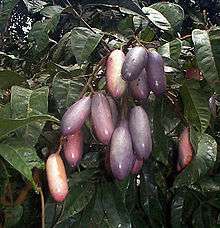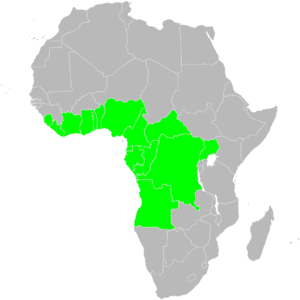Dacryodes edulis
| Safou | |
|---|---|
 | |
| Scientific classification | |
| Kingdom: | Plantae |
| (unranked): | Angiosperms |
| (unranked): | Eudicots |
| (unranked): | Rosids |
| Order: | Sapindales |
| Family: | Burseraceae |
| Genus: | Dacryodes |
| Species: | D. edulis |
| Binomial name | |
| Dacryodes edulis H.J. Lam | |
 | |
| Native distribution of the Safou[1] | |
| Synonyms | |
| |
Dacryodes edulis or safou is a fruit tree native to Africa, sometimes called Atanga (Gabon),Ube(Nigeria),[2] African or bush pear or plum, Nsafu, bush butter tree, or butterfruit.
Description
Dacryodes edulis is an evergreen tree attaining a height of 18–40 m in the forest but not exceeding 12 m in plantations.[3] It has a relatively short trunk and a deep, dense crown. The bark is pale gray and rough with droplets of resin. The leaves are a compound with 5-8 pairs of leaflets. The upper surface of the leaves is glossy. The flowers are yellow and about 5 mm across. They are arranged in a large inflorescence. The fruit is an ellipsoidal drupe which varies in length from 4 to 12 cm. The skin of the fruit is dark blue or violet, whereas the flesh is pale to light green. The tree flowers at the beginning of the rainy season and bears fruits during 2 to 5 months after flowering. There are two variants of Dacryodes edulis: D. e. var. edulis and D. e. var. parvicarpa. The fruit of D. e. var. edulis is larger and the tree has stout, ascending branches. D. e. var. parvicarpa has smaller fruit and slender, drooping branches.
Habitat and range
The preferential habitat of D. edulis is a shady, humid tropical forest. However, it adapts well to variations in soil type, humidity, temperature and day length. The natural range extends from Angola in the South, Nigeria and Sierra Leone in the West and Uganda in the East. It is also cultivated in Malaysia.
Oil composition from fruits of two cultivars of African pear in Cameroon
The oil of fruits of D. edulis is a rich source of fatty acids and triglycerides. The fatty acid compositions of fruit pulp oil of 2 cultivars of D. edulis (cultivars 1 and 2, grown in Cameroon) were determined. Fruits significantly differed in mass, length, thickness of pulp and mass of kernel, but contained similar amounts of oil (64.7 and 62% in cultivars 1 and 2, respectively, with ratios of oil:fruit of 1.4 and 1.54, respectively). The fatty acids (palmitic, oleic, stearic, linolenic and linoleic acids) and triglycerides compositions of oils of both cultivars were similar (although cultivar 1 was richer in palmitolino-olein (18.5 compared with 14.1%) and cultivar 2 was richer in dipalmito-olein (24.6 compared with 16.2%)).[4]
Uses
D. edulis has potential to improve nutrition, boost food security, foster rural development and support sustainable landcare.[5]
Fruit
The main use of D. edulis is its fruit, which can be eaten either raw, cooked in salt water or roasted. Cooked flesh of the fruit has a texture similar to butter. The pulp contains 48% oil and a plantation can produce 7-8 tons of oil per hectare. The fat content of this fruit is much higher compared to fruits such as apple, guava, and pawpaw.[6] It is also rich in vitamins. The kernel can be used as fodder for sheep or goats. The flowers are useful in apiculture. Shade tolerant traditional crops, such as Xanthosoma sagittifolium and taro can be co-cultivated with D. edulis.
Timber
The wood of D. edulis is elastic, greyish-white to pinkish. The wood has general use for tool handles, and occasionally for mortars, and is suitable for carpentry.
Seed
The seed of Dacryodes edulis is rich in different proportion of carbohydrates, proteins, crude fibres, appreciable amounts of potassium, calcium, magnessium and phosphorus. It is also rich in essential amino acids such as Lysine, Phenylalanine, Leucine, Isoleucine. It contain a considerable amount of fatty acis such as palmitic acis, oleic acis and Linoleic acids[7] Physicochemical analysis suggested that the seed have valuable functional attributes of industrial interest[8]
Medicinal Uses
The tree is also a source of many herbal medicines.[9] It has long been used in the traditional medicine of some African countries to treat various ailments such as wound, skin diseases, dysentery and fever. The extracts and secondary metabolites have been found to show biological activities such as antimicrobial, antioxidant [10] and anti sickle-cell disease. A wide range of chemical constituents such as terpenes, flavonoids, tannins, alkaloids and saponins have been isolated from the plant.[11]
Other uses
The resin is sometimes burnt for lighting or used as a glue. The tree is used as an ornamental plant and is known to improve soil quality by providing large quantities of biomass.
Nomenclature
The name of the genus comes from the Greek word for tear, dakruon. This is a reference to the resin droplets on bark surface of its members. The species name edulis means edible.
References
- ↑ Dacryodes edulis at worldagroforestry.org
- ↑ Dacryodes edulis at zipcodezoo.com
- ↑ Information page at World Agroforestry Centre
- ↑ Kapseu, C.; Tchiegang, C. 1996 Fruits Paris 51(3): 185-191
- ↑ National Research Council (2008-01-25). "Butterfruit". Lost Crops of Africa: Volume III: Fruits. Lost Crops of Africa. 3. National Academies Press. ISBN 978-0-309-10596-5. Retrieved 2008-08-01.
- ↑ Omogbai B. A., Ojeaburu S. I. Nutritional Composition And Microbial Spoilage Of Dacryodes edulis Fruits Vended In Southern Nigeria. http://www.scienceworldjournal.org/article/view/8457
- ↑ Annotated Bibliography of Safou (1990-2004) - International Centre for Underutilised Crops (ICUC) - Google Books. Retrieved 2014-08-08 – via Google Books.
- ↑ Iyawe, Hanson (2009). "Toxicants And Physicochemical Characteristics Of The Seeds Of African Black Pear (Dacryodes edulis)". African Journal of Food, Agriculture, Nutrition and Development. 9 (7): 1561–1569.
- ↑ http://docsdrive.com/pdfs/academicjournals/rjmp/2011/32-41.pdf
- ↑ Omonhinmin A Conrad and Agbara I Uche (2013) Assessment of In vivo antioxidant properties of Dacryodes edulis and Ficus exasperata as anti-malaria plants.Asian Pac J Trop Dis. 2013 Aug; 3(4): 294–300
- ↑ Ajibesin K.K. 2011. Dacryodes edulis (G. Don) H.J. Lam: A review on its medicinal, phytochemical and economical properties. Research Journal of Medicinal Plant 5(1):32-41
| Wikimedia Commons has media related to Dacryodes edulis. |
External links
- Safou. International Centre for Underutilised Crops, Southampton, UK. Factsheet No. 3
- Dressler, S.; Schmidt, M. & Zizka, G. (2014). [http://www.africanplants.senckenberg.de/root/index.php?submitForm=true&page_id=77&searchTextMenue=Dacryodes+edulis&filterRegionIDs[]=6&filterRegionIDs[]=1&filterRegionIDs[]=2&filterRegionIDs[]=3&filterRegionIDs[]=5 "Dacryodes edulis"]. African plants – a Photo Guide. Frankfurt/Main: Forschungsinstitut Senckenberg.